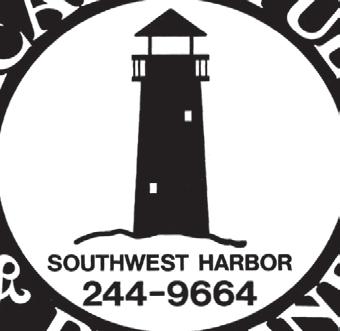
5 minute read
Town meeting, painting lines, eating doughnuts, and throwing rocks
By Barbara Fernald
The analysis and action plan was commissioned in the spring of 2022 by Town Manager Kathleen Billings and the board of selectmen from nationallyrecognized Camoin Associates. The process included multiple sessions, beginning in August 2022 and continuing through early 2023, with diverse groups of residents and business owners.
Advertisement

ACTIVITY on the islands, at the end of February and into March, is like a mirror image of the action at the end of August into September. Just as the summer residents of the Cranberry Isles end their vacations right before fall, many year-round residents end their winter breaks just before the spring equinox.
“With the changes and threats to our $55 million dollar a year fishing industry, I know we have to be better prepared than we are now to face what’s next,” said Billings, herself a seventh generation islander.
It’s time to get back to work and reconnect.
Our annual town meeting takes place on the second Saturday in March. For selectmen and town employees, winter has been anything but a vacation. They have been working steadily, gathering information to write the warrant for town meeting. It’s the time of year we come together as a town to decide on projects and spending and how much money is to be raised by property taxes.
“Stonington has always been resilient and able to roll with the punches. But our fishery and with it our year-round community are now facing some of the biggest challenges I’ve seen, and so are Maine’s other coastal communities,” she said. “We think Stonington can and should be a model for how to proceed differently.”
The town’s economic resiliency strategy is built on a clear-eyed
Discussion of the school budget alone can take well over an hour. The islands take turns hosting the meeting and the luncheon. This year, town meeting will take place on Islesford. What’s for lunch? Homemade pizzas, salads, and desserts. Life gets busier as we volunteer to help prepare the first community meal of the season. understanding of Stonington’s many assets and strengths, and is prioritized by those things over which a municipal government has direct control (infrastructure, land use policies, governance) and significant influence (housing, local education), while also identifying areas where the municipality’s support can make a difference, such as business, workforce, and entrepreneurship.
• Build community capacity through governance and civic structures
• Develop more sustainable, longerterm visitation through arts, recreation, cultural heritage, and natural resource-based approaches bright red with a black stripe) and, like every other lobster fisherman in Maine this winter, he read about, talked about, and experimented with purple paint.
The report identifies three core and six supporting strategies for building a more resilient community.
Core Strategies:
• Retain, attract, and educate a yearround population and workforce
• Support the “blue economy” (lobstering, fishing, clamming, smallscale aquaculture, marine trades)
Town meeting is a great opportunity to hear about winter from friends and neighbors. “How was your trip to ...?” “Who knew grand-parenting was so exhausting or that there were so many cold germs involved?” “You did all that painting?” These same questions could be asked in September at a school board meeting in a large suburb. (Preferably not during the meeting while someone else has the floor!)
• Continue to develop Stonington’s communications and marketing ability, giving visibility to the town as Maine’s No. 1 port, uniquely branding its products and attracting funding/people/ resources piece of purple rope to the end of the buoy line or toggle, but all attachments must be made with a splice or a tuck.

“In the multiple sessions we held with residents, it became easy to identify an imperative for action,” said Linda Nelson, the town’s economic and community development director.
• Maintain and invest in infrastructure and land use policies that support a resilient economy
Supporting strategies:
• Support workforce and education via housing strategies and recruitment
• Support entrepreneurship and identify opportunities for small businesses

In January and February, Bruce and I got to spend a lot of time with our grandchildren in Southern Maine. Visiting them was the main goal of most of our winter travel. We considered trying to paint our kitchen, but we kept catching odd coughing viruses and experienced more down time than we wanted, so we never got to it. Maybe I’ll paint it in May, when I can have the windows open.
The latest whale regulations require all Maine lobster fishermen to use new markings on the ropes they attach to lobster traps. Depending on how close to shore they fish, they will have to add 2-4 purple marks on each buoy line. On warps that are 100-feet or less there must be one 12-inch purple mark within a few fathoms of the trap and a 36inch purple mark within 2 fathoms of the buoy. If the warp is longer that 100 feet, the requirement is for a 12-inch purple mark near the trap, a second 12inch purple mark halfway to the buoy, and a 36-inch mark near the buoy.
“Our increasing lack of capacity to support a local workforce and schools is turning Stonington into the seasonal community none of us ever wanted it to be, and that in turn is gutting services and opportunities for year round residents. It is a vicious cycle.” as well as a 2019 sea-level rise adaptation report created for the town by GEI Engineering. It includes five high priority actions in areas including increased access to Stonington’s working waterfront; the development of low-to-moderate income housing; increasing water company capacity and storage; transportation infrastructure remediations for climate resilience; and the prioritization and planning for new commercial areas and activity.
I know it’s a stretch to compare following Maine whale rope requirements with a plein air workshop, but a person could return home from either and say that they’d been painting in their spare time. If Bruce were writing an essay on how he spent his winter vacation, painting would be a part of it. Another part would be the description I heard him tell his brother Mark about walking to get doughnuts, in February, with our son Robin, and our grandchildren Henry and Cora. I was away with friends in Portland, and Stephanie was away with friends in Florida. Father and son were in charge.
“Stonington is a remarkable Maine place,” noted Jim Damicis, founding partner of Camoin Associates and the lead consultant on the project. “Facing issues impacting communities everywhere as well as those unique to coastal communities including climate change, sea-level rise, housing, and workforce, this small island community is taking action to be future ready and resilient. Stonington is critical to Maine’s future in the blue economy.”
“Yeah, we got doughnuts at The Cookie Jar and then walked to the beach for a picnic and to throw rocks.”
• Develop the financial/fiscal capacity to support funding priorities, including a capital plan

Bruce saw more than enough paint, anyway, this winter. During his “time off” he painted 600 buoys (white and
Stonington’s economic resiliency strategy includes the framework for a capital budget plan and priorities to be used for the town to aggressively pursue funding resources.
The budget framework is aligned with the town’s comprehensive plan
Bruce figures he will be putting 1,500 to 1,800 markings on his rope in all; two to three weeks of extra work if he does it without hiring help. A number of fishermen are applying paint to their ropes by resting them in 3-foot long gutters made from lengthwise-halved PVC pipe. Bruce’s first attempt was with spray paint but he soon moved on to the more efficient brush and latex paint.
Some fishermen will add a 3-foot
Eating homemade donuts and throwing rocks at the beach—if that isn’t a mirror image of many childhood summers on Islesford, I don’t know what is. q
More than 50% of the 80-page strategy document contains the data analyses on demographics, jobs, incomes, and more on which the strategy recommendations are based and which can be used by the town in future funding requests.
The full report is available at www.stoningtonmaine.org.
Barbara Fernald lives on Islesford (Little Cranberry Island) with her husband Bruce.
Acadia Marine









